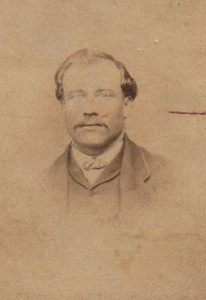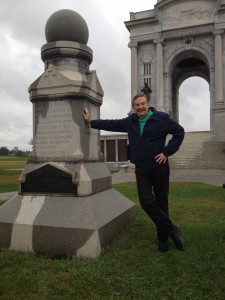In an earlier post, titled Grave Walking for Julia, I wrote about Linda’s and my search for my three times great grandmother, Julia Pixley. In that post I didn’t mention her son, Tom Pixley – my two times great grandfather.
We found Julia’s grave in the little town of Fabius in Onondaga County, New York. That’s where Julia grew up, where she was married and where her son, Tom, and her daughter, Caroline, were both born. Then the Pixley family moved to Wisconsin where they tried homesteading on the plains west of Milwaukie. Julia had two more daughters while in Wisconsin, and then her husband drowned. Having little choice, Julia sold the homestead and moved back to New York State where her family could help raise the children.
I learned through the 1850 US Census that Julia kept ten year old Tom and his two younger sisters with her in Fabius, but sent twelve year old Caroline twenty five miles away to live with Julia’s two brothers in the town of Galen. Five years later Tom turned fifteen and Julia decided it was time for him to learn a trade, and that trade would be farming. The 1855 New York State Census confirmed Julia brought Caroline back to live with her in Fabius and she sent Tom off to live with his father’s relatives, James and Fannie Sperry, who lived in Henrietta up near Rochester. James Sperry was over sixty years old and a professional surveyor, but his son, Edward, was only ten years older than Tom and he was a farmer, so the responsibility for teaching Tom about farming fell to Edward.
Family lore has cast Tom to be an adventurous lad, so I imagine he looked at a lifetime of farming much like a prison sentence, but at fifteen he had little say in the decision. Five years later the 1860 US Census confirmed, like it or not, Tom had, indeed, become a farmer. Then a year later he got his reprieve – on April 12, 1861 the Confederacy shelled Fort Sumter and the Civil War began. Patriotism ran high in New York State and soon Tom heard word of a cavalry unit being recruited in nearby Rochester. That must have sounded pretty exciting to a young man who didn’t want to be a farmer. Tom turned twenty one in August of that year, and immediately enlisted in the 3rd New York Cavalry and embarked on a grand adventure.
This posting is not about Tom’s experiences in the cavalry, I will tell those stories at a later time. This posting is about how I discovered Tom’s odyssey in the uncertain years just after the war.
The Civil War ended four years after it began and Tom mustered out of the cavalry on November 29, 1865. I’m sure Tom went home to Fabius for Christmas that year to visit what remained of his family, but there wasn’t much there for him. His mother died before the war and his older sister and grandmother both died while he was away fighting. His younger sisters were still living in Fabius with their uncle, Elmore Wheaton, but they certainly didn’t need Tom – actually, since he had been sent away when they were only nine and ten years old, Tom’s sisters hardly knew him. So Tom dropped out of sight (to me anyway) for almost six years before he reappeared in Neosho County, Kansas and married my great-great grandmother, Mary Jane Orcutt, on July 2, 1871.
I have said this story is about Tom Pixley’s life after he left the army, but I had no family stories to guide my search – in fact, I wasn’t even looking for those years when we found them. Linda and I were at the National Archives in Washington, researching our relatives who fought in the Civil War when I pulled Tom’s original 1910 request for his army pension. Through that request Tom himself told me about those missing years.
He wrote “I had several places of residence after leaving the service. From the spring of 1866 to 1868 I lived in Helena, Montana”. Tom didn’t say why he went to Montana, so I started looking for reasons an adventurous young man, fresh out of the army and with no responsibilities, would travel 2000 miles to live in Helena, Montana. It didn’t take long to find the reason; in 1864, along a little gulch in the Prickly Pear Valley, gold was discovered and the town that sprung up along both sides of the gulch would soon be named Helena.
Tom left the army just in time to join the stampede of prospectors headed for Montana to find their fortunes. The population of Helena swelled from 200 in 1864 to 3,000 when Tom arrived in 1866. In just four years gold, valued at 220 million of today’s dollars, was pulled from that gulch. Hundreds of businesses sprung up to serve, or fleece, the newly arriving fortune hunters while lawlessness flourished in the streets. Vigilantes provided the law and order in the gold fields and frontier justice was often handed out in the form of a good lynching.
Work in the gold fields was hard. Helena was dangerous and Tom never made his fortune, so in1868 he left Helena for good.
To Be Continued …


 I don’t want to just find my ancestors; I want to discover their life stories and maybe unwind a few family mysteries along the way. Ancestry.com is great for identifying those long dead relatives, but sometimes the best information is not on line at all, sometimes you have to go looking for an original document in a courthouse or church. I love that kind of search, where my reward is finding a document that has been untouched for over a hundred years.
I don’t want to just find my ancestors; I want to discover their life stories and maybe unwind a few family mysteries along the way. Ancestry.com is great for identifying those long dead relatives, but sometimes the best information is not on line at all, sometimes you have to go looking for an original document in a courthouse or church. I love that kind of search, where my reward is finding a document that has been untouched for over a hundred years.
Recent Comments